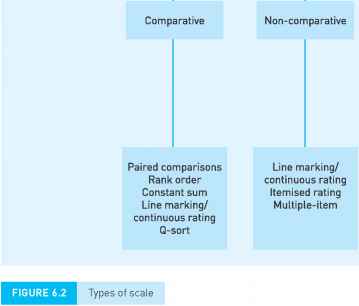Comparative scales
This type of scaling ensures that all respondents approach the rating task from the same known reference point. There are several variations in the technique used.
Paired comparisons
The respondent is presented with two objects at a time and is required to indicate a preference for one of the two according to some stated criterion. The method yields ordinal scaled data, for example, brand A is better than brand B, or, brand

A is cleaner than brand B and so on. It is often applied in cases where the objects are physical products. One important point about data obtained through paired comparisons is that the ordinal data can be readily converted into interval-scaled data.
Rank order scale
In this case, respondents are presented with several objects simultaneously and required to order or rank them.
Constant sum scale
Respondents are asked to allocate a number of points - say, for instance, 100 points - among objects according to some criterion, for example, preference or importance. They are instructed to allocate the points such that if they like brand A twice as much as brand B, they should assign brand A twice as many points.
Line marking/continuous rating comparative scale
This is often used to obtain similarity judgements. Usually, respondents are presented with object pairs and asked to judge their similarity by marking a five-inch line anchored by the phrases 'Exactly the same' and 'Completely different'.
Rolex and Longines
Please indicate how similar you believe these two brands of watch to be by placing an X on the line below at the point that approximates your judgement.
Q-sort scale
This scale employs a rank order procedure in which objects are sorted into piles based on similarity with respect to some criterion. Respondents are presented with a set of objects (brands, concepts, words or phrases) and are told to sort them into piles, according to some criterion. For instance, a respondent might be given a set of brands and asked to sort them according to which are the most similar to the person's ideal brand.
Once the respondent has completed the Q-sort, each item is assigned a rank order. The data are ordinal in nature and can be analysed with statistical procedures that are suitable for these types of data.
Continue reading here: Semantic differential scale
Was this article helpful?
Readers' Questions
-
Robinia1 year ago
- Reply